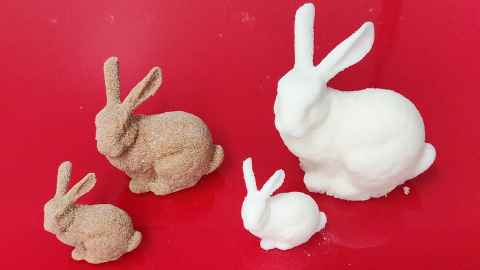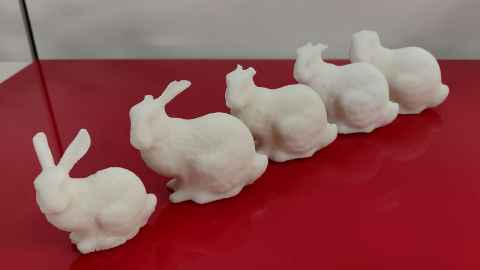Hopping into the world of 3D-printed food
3 September 2020
Professor Olaf Diegel and Dr Arno Ferreira have recently made progress towards a tastier approach to 3D printing.

Things have started becoming a little sweeter at the Creative Design and Additive Manufacturing Laboratory in the weeks following Aotearoa’s first lockdown. After their ad hoc production run of safety equipment in the wake of Covid-19, Professor Olaf Diegel and Dr Arno Ferreira are back to their usual business of experimentation. This time, they’re tackling the field of additive manufacturing for food, and have started with chocolate.
While appliances for printed food are already available to home consumers, the work is focused on finding a better alternative to the common method of extrusion-based printing. “This involves putting ingredients in a syringe, basically, and squeezing it out, but the main problem with extrusion is that you can’t scale it up. If it takes you an hour to produce one chocolate, you’ll have to wait ten hours to print ten," Professor Diegel says.
Their solution is a standard 3D inkjet printer – one 'hacked' by Professor Diegel and Dr Ferreira – with chocolate powder as a base material, and additives used as the “liquid glue” binders. The main advantage is time; the chocolates can be stacked on a grid so more can be printed in one go, from their bottom to top layers. Once the formula is perfected, larger-scale production would theoretically be a much simpler task. “There’s a company in Germany that makes a printer that isn’t for food, but it measures about 4m x 2m x 1m. Imagine how many meals you could produce on one of those."
For now, their main challenge is getting the recipe right. Dr Fererra’s experiments with the formula have involved mixing water, ethyl alcohol and sugar with a number of different varieties of powdered drinking chocolate. “Nestle is not sponsoring us yet, but they should," Professor Diegel jokes.
With the different mixes, they’ve printed small, medium and large “bunny rabbits, because we needed something with fragile bits on it. The ears are perfect, because we can see that if they don’t break, the recipe’s good. A more solid shape would have been too easy."

The two researchers have been tasting their results, and agreed that the use of chocolate powder – due to technical requirements, as the printer is designed for materials such as plaster of Paris – was the most complicated element of the recipe so far. Due to the composition of chocolate powder, the end product is dry and crumbly, and for the researchers, what’s truly missing is the fatty, buttery consistency, flavour and “goodness” of chocolate.
The sugary treats are just the first step in a longer-term plan, with a part of it being an upcoming collaboration with the New Zealand Meat Council, and a brand new inkjet printer with five heads instead of one has arrived just in time for them to get to work. Professor Diegel explains, “It involves taking the waste that would normally get washed away, turn it into powder, and eventually produce not cheap hamburgers, but high-value custom steaks." Their experiment with chocolate confirms that there’s still a lot to learn, including emulating the textural and chemical compositions of specific cuts.
With the two new experimental printers, the future of their research looks hopeful, and can soon involve student projects, even at undergraduate level. It also reinforces the justification of additive manufacturing for food production beyond a novelty. Because their end products are customisable in countless ways – from shape and colour to textures, nutritional value, and flavours – the scope for applications is extremely broad. The oft-mentioned example is in rest homes, for individuals with specific textural and nutritional needs.
“This is where we need to collaborate with people in food engineering and science, and beyond. We can build the machines and make things print the right way, but we don’t have all the expertise in everything”, Professor Diegel states.
“We can’t always tell what’s next. For now, it may just be chocolate and meat, but soon it’ll be broccoli or chicken or full meals. For our Engineering students, there may be a need to include heating in these printers so we can cook food as they are being printed. There’s also a social studies element to all the work here, where there’s an uncanny valley element to, if we should say, print a chicken to look like a drumstick, or a different shape. There’s a lot of potential out there for work to be done, which is quite exciting.”